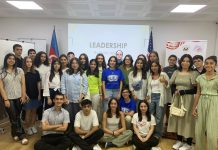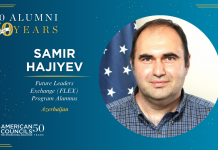Khadija Suleymanova ’18 (Ganja, Azerbaijan / Columbus, OH)
Since returning to Azerbaijan after FLEX, Mahammad Kekalov ’18 (Zaqatala, Azerbaijan / Boonsboro, MD) has made it his mission to advocate for people with disabilities and to be the starter for change in the community.
From his adaptive fashion brand, KekaLOVE, to his current project, KekaMaps, he continues to put forth creative solutions to ongoing issues in Azerbaijan.
KekaMaps works alongside the local community in Baku to map buildings in their local area that are inaccessible to people with disabilities through an interactive website. When an individual adds a place and supporting photos to the website’s map, information is automatically sent to local government authorities.
During his year in the U.S., Mahammad, with the help of his host mother Marlene Powell, gained very important knowledge and understanding about people with disabilities. She arranged volunteering opportunities for him at the local resource center for families with disabled children.
“I developed my personality and character significantly and matured emotionally, gaining skills that have helped me do fundraising, promotion, volunteer management, and general strategy setting for this initiative today,” Mahammad said.
The following is an interview with Mahammad.
Tell us about KekaMaps. How did it start?
It started when my friends and I decided to apply for a project funded by the European Union. After approval of our application, we were offered a grant to take on one of the EU’s most successful projects and adapt it for Azerbaijani citizens in a local context.
The EU hackathons – which bring together around 50 civil society activists, IT professionals and designers from the east Asia partnership countries to work on civic tech projects addressing the needs of communities, helping citizens to better hold their governments to account – have done a great job identifying promising ideas from across the eastern partnership region, which has six partner countries: Azerbaijan, Armenia, Belarus, Georgia, Moldova, and Ukraine. One of these ideas was the methodology and the concept KekaMaps is based on. Our work colleagues in Ukraine’s disability conclusion area first developed this program to allow citizens to monitor and map inaccessible buildings.
A building qualifies as inaccessible if it fails to serve people with disabilities. For example, it might lack elevators, Braille signs, handicapped bathrooms, or information desks might be too tall for those in wheelchairs.
We took it even further in Azerbaijan by building a user-friendly interface and a successful user-engagement strategy. Our system is built on the premise that the local government will cooperate with us, and we will support their mission by visiting the buildings that need our attention and identifying them.
Now citizens can log in to select the buildings in the areas they want to map. Then they are taken to a reporting page where they enter their name and phone number. Finally, the information is forwarded to local authorities as local reports.
What was the inspiration behind this project?
We worked with Ukrainian colleagues on this project, and it was their idea that we would adapt the system for Azerbaijan. In general, there are more than 650,000 persons with disabilities in Azerbaijan who can’t access their fundamental rights and privileges due to inaccessibility issues in our country. They can’t receive quality education or access basic healthcare needs because the buildings these services are located in are not fit for people with disabilities.
What goals have you reached so far since starting KekaMaps?
We managed to bring around ten young people on who are committed to working on KekaMaps as volunteers. We dedicate three hours each Saturday afternoon to walk around the city on the streets that we choose and send data on the buildings located on these streets. So far, we have walked around 15 kilometers on foot and collected well more than 1,200 reports. Our main purpose is to get these buildings fixed and for that, we’re trying to work closely with local authorities.
Where do you see KekaMaps in the future?
I see big potential in KekaMaps, and that’s the main reason why I am investing my time and energy into expanding this solution. The future I envision for my website is for it to be a go-to app when people don’t see appropriate access for persons with disabilities, but unfortunately, there are not a lot of people joining the app. My friends always tell me they think of me first when they see a piece of infrastructure without proper disability access. Our goal is to make sure all buildings are accessible for everyone, and that people are utilizing our map not just in Azerbaijan, but also in other FLEX and YES program countries where access is a problem for citizens with disabilities.
As a successful entrepreneur, what advice would you give to someone who would also like to make a change in their community?
I would like to tell them to approach the problem from a comprehensive perspective. It’s important to include your target beneficiary group when you first design your solution. They need to be fully involved and have their honest say in how your project is being designed, so it can be of maximum efficiency for your target group. And don’t be so hard on yourself! A successful entrepreneur is one who never doubts themselves and never backs out on implementing their new, crazy and bold ideas.






